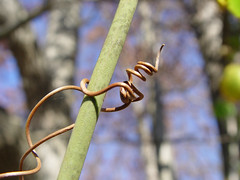
A few weeks ago I re-hung the wire that supports a climber out on the patio. Each week since then I've spent some time with some nylon cord tying up new shoots. My long term goal is to have a lush climber roof. I expect it will take about five years to get where I'm going.
One thing I've noticed is that left to themselves many of the new shoots will start climbing back up themselves. This isn't such a good idea because as the branch thickens it must eventually strangle itself. The shoot grows without thought of the future. The plant itself cares nothing for the individual shoot. Some shoots will survive and that is all the plant cares about. There must be growth regardless of the price. The shoot expends it's energy expanding. The plant expends it's energy creating new shoots. But we the gardener have a long time plan. So we expend our energy manipulating the shoots towards our long term goal. What we do helps the shoot because we increase the individual shhots chances of survival. We help the plant because we provide more opportunities for new growth.
The plant reminds me of a business. It needs to grow so it expends it's energy creating new shoots (this could mean a bigger store, a new store, a new product line). The business doesn't care about the long term impact of it's growth it only cares about growth. So who is the gardener? As individuals we can't do much to effect the business. We can form groups to effect change and sometimes these groups can make a difference. But for groups to make a difference they need to focus on individual shoots (i.e processing oil in a specific way causes pollution). This focus can make it difficult to keep an eye on the long term goal. Inevitably the real gardener is the government.
The current Australian government believes in letting the market find it's own way and has worked hard to give the market more freedom. This has lead to much growth and now we are in an election year they point to this growth as proof of their competance. But we all know what eventually happens when the gardener hands over responsibility to the garden.











































